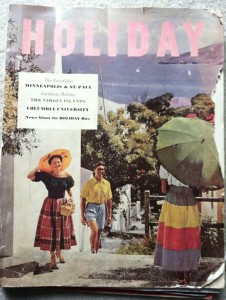 It’s inevitable: someday, perhaps someday soon, magazines on paper will cease to exist. I don’t know if books will go the same route–I hope not, though I know most will–but as the generation being weaned on iPads and tablets grows older, the need for that weekly paper digest will simply vanish.
It’s inevitable: someday, perhaps someday soon, magazines on paper will cease to exist. I don’t know if books will go the same route–I hope not, though I know most will–but as the generation being weaned on iPads and tablets grows older, the need for that weekly paper digest will simply vanish.
Magazines, and especially their advertisements, are a fascinating way to look at the culture of America from the 1940s through the 70s (and probably the 80s and 90s, but for now those have little interest.) Someday, when we want to look into the buying habits and fashion tastes and diversions of another time, historians might turn to the magazines and newspapers. Because they were the swiftest method of communicating via print media at the time, they are, in a sense, the internet of yesteryear.
What troubles me is that in the future curious historians will have a difficult time with the internet. For internet pages vanish. If a magazine, like Holiday (left–which will be the subject of this rambling piece), goes out of business, who’s going to pay to keep its pages alive on the web? Out of date internet advertising certainly won’t remain–it won’t be kept on video or film, like television shows, and it won’t be archived even if said periodical thrives.
And so, despite this being the age of information, the peripheral information, hell, maybe even the articles themselves, may simply vanish, like the scrolls in the Library of Alexandria. Read them now. Watch them turn to virtual dust later.
From reading these columns, you may have recognized that I have a fascination with old Life magazines and such, and my discovery of the aforementioned Holiday magazine at a weird and soggy condo conjured up thoughts of the great old Library. We hit nine sales total this weekend, four on Friday and five on Saturday with ESC Special Guest Stars Anne & Erik R. Most fascinating were easily the pages of the magazines I found.
 After a modest sale in Edina, featuring scores of old, worthless books (like Think and Grow Rich, for “The Man and Woman Who Resent Poverty”), Janice and I took in a sale on Lake Calhoun. This was cool if only for the fact that I have wanted to climb those worn out concrete steps across the street from the lake path, the ones that read “Private Property, No Trespassing.” Climb through the overgrowth and you emerge onto a little mall of condos like the one in the photo, and a plain of grass that squishes beneath your feet. This means that the drainage is horrible, and that the parking garage underneath, and the basements around it, are no doubt soaked and mildewy. Go into the condo in question (above) and you walk up stairs with the ghostly dust shadows of frames that had been hanging on walls for years and years. Yikes!
After a modest sale in Edina, featuring scores of old, worthless books (like Think and Grow Rich, for “The Man and Woman Who Resent Poverty”), Janice and I took in a sale on Lake Calhoun. This was cool if only for the fact that I have wanted to climb those worn out concrete steps across the street from the lake path, the ones that read “Private Property, No Trespassing.” Climb through the overgrowth and you emerge onto a little mall of condos like the one in the photo, and a plain of grass that squishes beneath your feet. This means that the drainage is horrible, and that the parking garage underneath, and the basements around it, are no doubt soaked and mildewy. Go into the condo in question (above) and you walk up stairs with the ghostly dust shadows of frames that had been hanging on walls for years and years. Yikes!
 This was the home of a gentleman named Harold, a former Minnesota State Representative, FBI man, lawyer, Commodore in the Aquatennial, and drafter of legislation to allow the sale of margarine in the state. He was, according to the obit, “a wonderful husband and father who served his nation and community well.” That simple line is a wonderful epitaph if you ask me.
This was the home of a gentleman named Harold, a former Minnesota State Representative, FBI man, lawyer, Commodore in the Aquatennial, and drafter of legislation to allow the sale of margarine in the state. He was, according to the obit, “a wonderful husband and father who served his nation and community well.” That simple line is a wonderful epitaph if you ask me.
 Harold not only served those organizations well, he also collected a bunch of weird stuff. There were two cases of little elephant figurines of no interest, and a case of buttons unearthed a Beatles fan club pin, a pair of LBJ buttons, and a bunch for George W. Bush. I had the feeling that Harold was a man who collected what he used and appreciated–as in, he was not the type of man who collected little elephants because he thought they were valuable, but because he generally dug them.
Harold not only served those organizations well, he also collected a bunch of weird stuff. There were two cases of little elephant figurines of no interest, and a case of buttons unearthed a Beatles fan club pin, a pair of LBJ buttons, and a bunch for George W. Bush. I had the feeling that Harold was a man who collected what he used and appreciated–as in, he was not the type of man who collected little elephants because he thought they were valuable, but because he generally dug them. Here was a patriot, who, probably, being from Minneapolis, was a Democrat in the State House, one of those law-n-order Dems who becomes a grouchy 9/11 Republican in later years. (Andy Sturdevant, decades long reader of this piece back when it was a broadsheet passed out on the trolley cars, looked up the man and discovered that he was “A lifelong Republican, it turns out.”) No, I don’t really know this, but I’m going by what I saw. So, when we discover a small gong commemorating years of service to the FBI, it was probably given to him for his service, just as he probably wore the LBJ button in ’64 and the GWB one in ’04.
This guy had a lot of stuff, including his old commodore’s jacket from his time working with the Aquatennial, and it fit, though it reeked like it’d been stored in the bottom of Lake Calhoun for a few years. But we emerged with a photo of an angry Billy Martin (with a cross sewn on his A’s cap), a few buttons, and some magazines.
As we left, a couple noted a sign warning people that shoplifting meant 90 days in jail. One guy said, “All right! Free food for 90 days!”
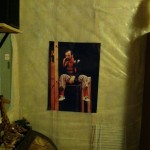 Unfortunately, for Anne and Erik the next day, our jaunt did not include all that many great sales. Our first took us to a strange home on the corner of Pillsbury and 31st, a place I’d stared at for ages from a distance, since whomever bought it (or whomever was flipping the place) razed an old home down below the foundation. This place was like a suburban home in a rough section of 31st–across from low-income housing, kitty-corner from those towering apartments next to the bus depot, an entirely new home with a tin roof, a basement with ten-foot ceilings, the works. Good luck selling the place.
Unfortunately, for Anne and Erik the next day, our jaunt did not include all that many great sales. Our first took us to a strange home on the corner of Pillsbury and 31st, a place I’d stared at for ages from a distance, since whomever bought it (or whomever was flipping the place) razed an old home down below the foundation. This place was like a suburban home in a rough section of 31st–across from low-income housing, kitty-corner from those towering apartments next to the bus depot, an entirely new home with a tin roof, a basement with ten-foot ceilings, the works. Good luck selling the place.
 This gentleman was moving, and is still alive, and was fixated on giraffes. There were hundreds of giraffe this and giraffe that, from lamps to salt and pepper shakers, to giraffe coat hooks, ties, shirts, and even the pair of old Life magazines I found related to giraffes. He was once a clown, or in a theater troupe that did circus-like numbers, which was cool. We purchased some cookbooks, a cool tie rack that matches your tie and shirt for you, and I scored a cheap pair of blue Doc Martin shoes.
This gentleman was moving, and is still alive, and was fixated on giraffes. There were hundreds of giraffe this and giraffe that, from lamps to salt and pepper shakers, to giraffe coat hooks, ties, shirts, and even the pair of old Life magazines I found related to giraffes. He was once a clown, or in a theater troupe that did circus-like numbers, which was cool. We purchased some cookbooks, a cool tie rack that matches your tie and shirt for you, and I scored a cheap pair of blue Doc Martin shoes.
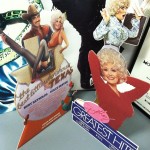 From there, we ended up in North Minneapolis, just off the Victory Memorial Parkway, and the sad home of a man whose partner had recently died of pancreatic cancer. “Dolly Parton lost her #1 fan” read the obit, and it sure seemed to be true. This was a pretty clean sale–I’m guessing the man who survived his spouse just wanted to clear out some sad memories. There were Dolly cut-outs (right), shirts, autographed framed photos, posters, and, of course, tons and tons and tons of CDs, DVDs, and LPs. He was also a fan of Debbie Harry and Reba McEntire. None of this stuff was going out the door, however.
From there, we ended up in North Minneapolis, just off the Victory Memorial Parkway, and the sad home of a man whose partner had recently died of pancreatic cancer. “Dolly Parton lost her #1 fan” read the obit, and it sure seemed to be true. This was a pretty clean sale–I’m guessing the man who survived his spouse just wanted to clear out some sad memories. There were Dolly cut-outs (right), shirts, autographed framed photos, posters, and, of course, tons and tons and tons of CDs, DVDs, and LPs. He was also a fan of Debbie Harry and Reba McEntire. None of this stuff was going out the door, however.
From there, it was a dour little home in Crystal, where I uncovered some weird books and a Morse code signaler that I didn’t buy, and then we hit a one-level rambler in Plymouth that finally netted our guests a rug and four kitchen glasses. The warehouse sale proved to be equally junky, and with that our weekend’s jaunt came to a close.
 As is my wont, Sunday mornings are spent with coffee and the old magazines I’ve just bought, including Holiday. Holiday was a strange little rag, which thrived from the late 40s through the mid-70s, when it was devoured by Travel magazine. It catered to those folks who had money and time, because there were ads for round-the-world travel and a whole page dedicated to boarding schools for your unruly child. I’m guessing Harold held onto this copy because of its hilarious and lengthy article about the Twin Cities, called “Embattled Twins”, by one Norman Katkov.
As is my wont, Sunday mornings are spent with coffee and the old magazines I’ve just bought, including Holiday. Holiday was a strange little rag, which thrived from the late 40s through the mid-70s, when it was devoured by Travel magazine. It catered to those folks who had money and time, because there were ads for round-the-world travel and a whole page dedicated to boarding schools for your unruly child. I’m guessing Harold held onto this copy because of its hilarious and lengthy article about the Twin Cities, called “Embattled Twins”, by one Norman Katkov.
Katkov was an interesting creature. He was born in the Ukraine, his family emigrated to St. Paul, and as an adult he left to pursue a career in writing in New York, then later to Hollywood, where he was nominated for an Emmy for some of his TV work. Holiday commissioned him to write a piece about the Twin Cities, and to look at the photos you’d think it was a complimentary piece about the dual vacationland we have here.
Not so. Mr. Katkov, in this article, comes across as a frustrated St. Paul crank, a man who takes every positive utterance about Minneapolis as a blow to the chin. Despite this–well, in part because of this–the article is a fascinating read, and an amazing look at a time gone by.
Katkov is quick to swing, opening his piece with a bit about how he’s boarding a plane home and everyone who hears he’s from Minnesota assumes he’s from Minneapolis. In Katkov’s world, if he mentions he’s from St. Paul, people stare at him, bewildered. He sits next to a guy from Minneapolis who talks the larger city up, and Katkov from then on calls him Homesick Harry… which is a stretch considering how much Katkov yaks about poor, beleaguered St. Paul.
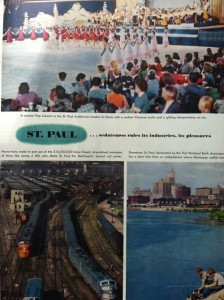 According to the piece, Homesick Harry bored Katkov to tears with his talk of the Walker Art Center (“although he may have driven past it on Lyndale Avenue for years without stopping”) and brags about the Minneapolis Millers (“although he may never have seen a game.”) This is a long, entertaining piece, in part because Katkov is such a grouch, reminding me of the many St. Paulites I worked with at the St. Paul Companies years ago, people who asked me, when I lived two blocks from Lake Calhoun, how anyone could exist in such a dangerous place, and who claimed to have visited Chicago more than Minneapolis.
According to the piece, Homesick Harry bored Katkov to tears with his talk of the Walker Art Center (“although he may have driven past it on Lyndale Avenue for years without stopping”) and brags about the Minneapolis Millers (“although he may never have seen a game.”) This is a long, entertaining piece, in part because Katkov is such a grouch, reminding me of the many St. Paulites I worked with at the St. Paul Companies years ago, people who asked me, when I lived two blocks from Lake Calhoun, how anyone could exist in such a dangerous place, and who claimed to have visited Chicago more than Minneapolis.
I might add that yes, I have been to the Walker Art Center and seen a ball game.
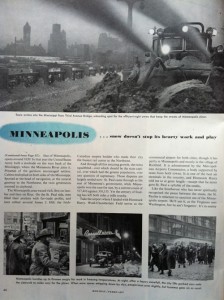 I was struck at the pettiness of the piece. “Does the St. Paulite know his way about Minneapolis? You bet!” Well, that could be because Minneapolis is laid out in a grid, with numbers and streets that actually make sense. If I’m told you live at 2704 Emerson Avenue South, I know you’re just south of the intersection of Emerson and 27th, and furthermore Emerson’s between Fremont and Dupont because the streets are in alphabetical order. I’ve been to St. Paul many, many times–hell, we even lived there for a year–and their house numbers don’t even correspond to blocks–the 800s, for instance, might run two and a half blocks. Not having street signs on some corners–common in St. Paul–also makes maneuvering difficult. It’s as if the city doesn’t care if you know where you’re going, since people who’ve lived there forever surely know where they’re going.
I was struck at the pettiness of the piece. “Does the St. Paulite know his way about Minneapolis? You bet!” Well, that could be because Minneapolis is laid out in a grid, with numbers and streets that actually make sense. If I’m told you live at 2704 Emerson Avenue South, I know you’re just south of the intersection of Emerson and 27th, and furthermore Emerson’s between Fremont and Dupont because the streets are in alphabetical order. I’ve been to St. Paul many, many times–hell, we even lived there for a year–and their house numbers don’t even correspond to blocks–the 800s, for instance, might run two and a half blocks. Not having street signs on some corners–common in St. Paul–also makes maneuvering difficult. It’s as if the city doesn’t care if you know where you’re going, since people who’ve lived there forever surely know where they’re going.
The editors at Holiday must’ve bristled at Katkov’s bile, because the photos show two vibrant cities, places where you, the reader, might want to visit. Both cities look great. And, oh my, does it show the Winter Carnival and Aquatennial in their heyday!
“Each year,” Katkov writes, “an ice palace is built, complete with great hall and battlements and a post office from which to mail souvenir postcards…” Holy cats. A post office? Katkov continues: “hundreds of firms take part in the opening parade, their employees dressed in distinctive uniforms… of a thousand color combinations.” How I wish this continued to this day–the St. Paul Companies never participated in the Winter Carnival when I was there in the mid-90s.

Photos show these vibrant parades, the grand ice palace, and, of course, the freaky drunken vulcans kissing unsuspecting women.
Of course, no city in the world had ever had a carnival of any kind before St. Paul’s Winter version, and so when Minneapolis started the Aquatennial, and promoted it with a color movie (how I’d love to see that) our writer gripes that “[o]nly in Minneapolis could borrow an idea and develop it with big time flourish.” Because, yeah, they should spend a lot of money on a summer festival and, like St. Paul (if Katkov is to be believed), do nothing whatsoever to promote the thing.
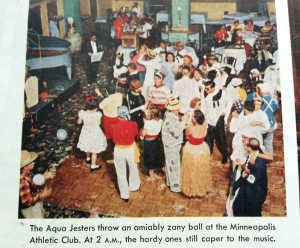 Having witnessed the utterly despairing winter carnival in the 1990s (bad ice sculptures, a parade few cared about, and that insane medallion hunt sponsored by the provincial newspaper that refuses to deliver in Minneapolis), and having ignored the Aquatennial, which at least has the benefit of being in the warmth of summer, I have to say that I would have loved to have participated in both of these fine events in their day. I mean, who wouldn’t go to the “Aqua Jesters” ball (right)?
Having witnessed the utterly despairing winter carnival in the 1990s (bad ice sculptures, a parade few cared about, and that insane medallion hunt sponsored by the provincial newspaper that refuses to deliver in Minneapolis), and having ignored the Aquatennial, which at least has the benefit of being in the warmth of summer, I have to say that I would have loved to have participated in both of these fine events in their day. I mean, who wouldn’t go to the “Aqua Jesters” ball (right)?
 Or who wouldn’t want to catch the “Aqua Dears” synchronized swimming show? Or mailed a postcard from an ice post office? Or cheered on motor boat races on Lake Nokomis? It looks like a hoot.
Or who wouldn’t want to catch the “Aqua Dears” synchronized swimming show? Or mailed a postcard from an ice post office? Or cheered on motor boat races on Lake Nokomis? It looks like a hoot.
Katkov’s piece takes some bizarre turns, such as when he states unequivocally that Minneapolis men never date St. Paul women. But he softens and writes about how St. Paulites consider Minneapolis’ chain of lakes to be a part of both cities. After renting a canoe on Lake Calhoun, Katkov writes that you can paddle fifteen feet and–
[Y]ou’ve shaken off this metropolitan area of nearly a million. For a time you can hear the cars and see their headlights. Then the sound dies down to the whish-whish, ever-fainter humming of the tires, and the headlights become as tiny and as swift as fireflies. You hear the water against the canoe and from far off the soft, muted pleading of a blues singer on somebody’s portable radio. The heat of the day leaves you completely, the stars grow brighter, come closer.
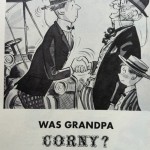 I love writing like that, simple and straightforward and full of loving detail. And look at the advertisements from the old magazines! “Was Grandpa Corny?” Here we see a young man lamenting the fact that he used to roll his eyes at Grandpa for being so damned loyal to his brand names… ah, but now that he’s older, he sees the wisdom in brand names. Brought to you by the Brand Names Foundation.
I love writing like that, simple and straightforward and full of loving detail. And look at the advertisements from the old magazines! “Was Grandpa Corny?” Here we see a young man lamenting the fact that he used to roll his eyes at Grandpa for being so damned loyal to his brand names… ah, but now that he’s older, he sees the wisdom in brand names. Brought to you by the Brand Names Foundation.
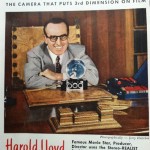 Or this one, with Harold Lloyd, for the Stereo Realist Camera. “Famous Movie Star… uses Stereo-REALIST for his personal pleasure.” Since we now know a lot of his “personal pleasure” involved naked pin-up photos, well, this takes on a whole new meaning.
Or this one, with Harold Lloyd, for the Stereo Realist Camera. “Famous Movie Star… uses Stereo-REALIST for his personal pleasure.” Since we now know a lot of his “personal pleasure” involved naked pin-up photos, well, this takes on a whole new meaning.
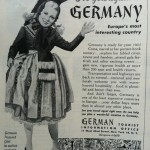 As does this ad for visiting Germany. “See you again in Germany!” This Holiday is from 1951, and World War II ended a mere six years earlier. “Transportation and highways are back to normal…”
As does this ad for visiting Germany. “See you again in Germany!” This Holiday is from 1951, and World War II ended a mere six years earlier. “Transportation and highways are back to normal…”
Holiday is filled with tons of ads for alcohol, nice suits, automobiles, cruises, air travel, cigarettes, and even a full-page ad from the International Book Club, giving away a free 768-page James Joyce sampler (“What’s your score on these questions about JAMES JOYCE?”) Damn it was a different time.
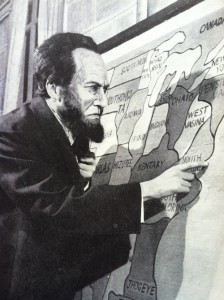 Life was much more popular, much more aimed at the middle class. From the 1946 Life with a giraffe on its cover, we get lots of ads of canned soups, life insurance, razors, soaps, and all the stuff we see today, except a bit more sexist and clumsy. But sometimes you get really bizarre articles, like “Japanese Lincoln”, about post-war Kibuki theater putting on a play about our 16th President. Note the misspelled map behind him–”West Vasina.” Hmm.
Life was much more popular, much more aimed at the middle class. From the 1946 Life with a giraffe on its cover, we get lots of ads of canned soups, life insurance, razors, soaps, and all the stuff we see today, except a bit more sexist and clumsy. But sometimes you get really bizarre articles, like “Japanese Lincoln”, about post-war Kibuki theater putting on a play about our 16th President. Note the misspelled map behind him–”West Vasina.” Hmm.
I love this old writing and these old-style advertisements–I find them intriguing just as I find them a bit sad (it’s sad that a sherry advertises itself as being a good drink “before lunch”.) But there’s a ton of great writing today, and even our advertisements, which are silly and stupid and mean as always, will go on to reflect our naive culture–we’re always naive to the future. But where are we going to find these articles and advertisements when the online magazine folds, or the ad goes out of date?
The answer is that we won’t, not really. At the very least they will not be available casually, to the interested seeker of the past. And especially not at estate sales. Look around you, look at the stuff you read this morning, at the advertisements you read. In one year, surely the ads will be gone. In five years, everything you’ve read might have vanished. Maybe that’s a good thing. Maybe we hold onto too much of our culture. But when I look at these old magazines, something tells me I’ll be lamenting this trend when I’m very old.

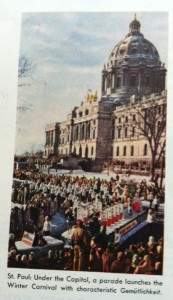

I thought this edition was overly anti-St. Paul. But I did love the image of the drunken Vulcan leaping into the crowd! I pinned about 10 of your images onto my Pinterest Board. I was sorry you did not include a photo of the angry Billy Martin.